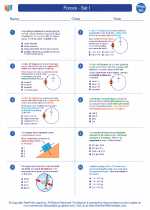Forces - Set I -> newton's second law
Newton's Second Law
Newton's second law of motion states that the force acting on an object is equal to the mass of the object multiplied by its acceleration. This can be expressed as:
F = ma
Where:
- F = force acting on the object (in Newtons)
- m = mass of the object (in kilograms)
- a = acceleration of the object (in meters per second squared)
This law demonstrates the relationship between the force applied to an object, its mass, and the resulting acceleration. It shows that the greater the force applied to an object, the greater its acceleration will be, and that a heavier object will require more force to achieve the same acceleration as a lighter object.
Study Guide for Newton's Second Law
To understand and apply Newton's Second Law effectively, it's important to grasp the following key concepts:
- Force: Understand the concept of force and how it is measured in Newtons. Be able to identify different types of forces acting on an object, such as gravitational, frictional, and applied forces.
- Mass: Know how to calculate the mass of an object and understand its significance in relation to Newton's second law. Be familiar with the units of mass (kilograms) and how mass affects an object's resistance to acceleration.
- Acceleration: Understand what acceleration is and how it is measured in meters per second squared. Be able to calculate the acceleration of an object given the force acting on it and its mass, and vice versa.
- Application of the Law: Practice solving problems and scenarios using Newton's second law. This includes calculating the net force acting on an object, determining its acceleration, and understanding how the mass of the object influences its motion in response to applied forces.
- Real-world Examples: Explore real-world examples and applications of Newton's second law, such as the motion of vehicles, the behavior of objects in free fall, and the dynamics of sports activities. Understanding these examples will help reinforce the principles of the law.
By mastering these concepts and applying them to various scenarios, you can develop a strong understanding of Newton's Second Law and its significance in the study of physics.
.◂Physics Worksheets and Study Guides High School. Forces - Set I

 Worksheet/Answer key
Worksheet/Answer key
 Worksheet/Answer key
Worksheet/Answer key
 Worksheet/Answer key
Worksheet/Answer key
